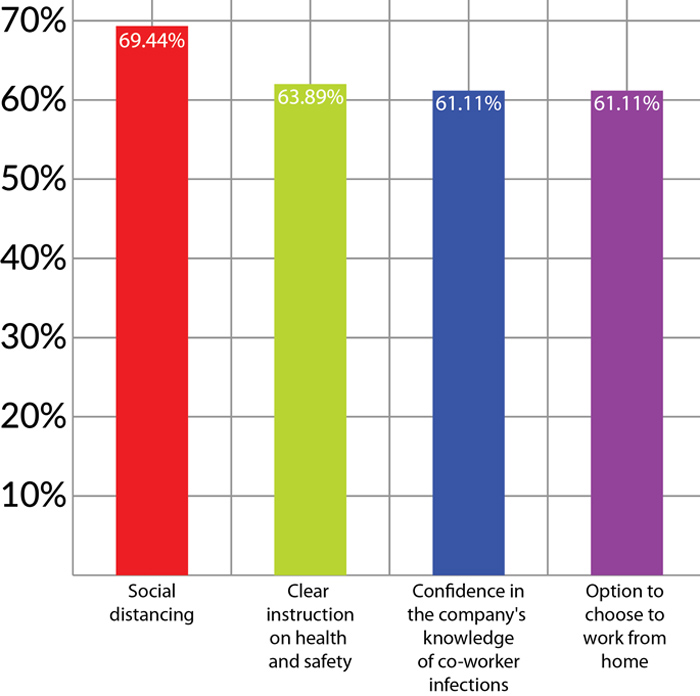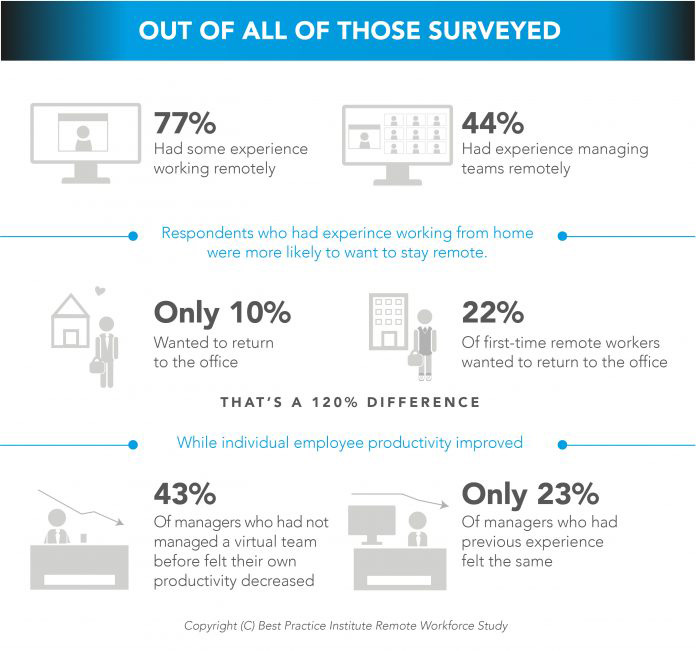In 2021, one question going through the minds of employees and CEOs alike is, “Is traditional in-office culture over, and the remote workforce here to stay?” Best Practice Institute studied remote worker psychology during the pandemic. We found some interesting findings when it comes to navigating the future of work.
As companies have had to shift to remote working during the COVID-19 crisis, we took a deeper dive into what was happening. In particular, we wanted to learn about productivity and employee preferences in the “new normal” working environment to understand what future office cultures may look like. Our clients were asking us some fundamental questions: What happens when all my employees suddenly work remotely? Does productivity go down? How does management change? Do employees want to go back to the office? And if so what changes need to be made so they feel comfortable and safe coming back?
Purpose of the Study
To meet the needs of my clients and member organizations, my company, Best Practice Institute surveyed over 3300 employees who have been working remotely from a wide range of industries with 100 – 10,000+ employees to better understand whether remote working is effective and should be considered a permanent option moving forward post-COVID-19. And, if it is not possible, what working conditions are necessary for employees, if coming back to the office was the only option.
In addition, we also surveyed over 280 CEOs from a similar range of company sizes and industries including financial services, manufacturing, insurance, government, hospitals/healthcare, aerospace, education, pharmaceuticals, food & beverages, real estate, retail, and others to find their preference on whether they want employees back in the office.
The discrepancy was stark, with over 83% of CEOs wanting their employees back in the office in 2021, while only 10% of employees wishing to be back in the office full time.
Did Productivity Decline? No, It Improved
The idea of remote working contradicts a traditional 9-5 working style that existed before technology took over and made it possible to easily send Slack messages and set up Zoom calls with employees across the globe. If an employee works on a computer all day, does it matter whether they’re physically in the office or working in their pajamas at home? The main concern for employers and managers is productivity and the fears that if employees aren’t in the office and supervised, they will not work as hard. Our findings debunked this common suspicion: 76% of respondents felt their personal productivity improved, and 72% felt their entire team’s productivity improved by working from home. This does not come without cost, however. Many people reported that working longer hours at home increased their stress and feelings of “burn-out.”
Do CEOs want employees back in the office? Yes they do
Do Employees Want to Go Back to the Office? Not Really
Only 10% of respondents want to go back to a fully in-office culture, 64% prefer to have a remote-friendly environment where they have the option to work from home part of the time. We examined employees across different industries to see their preferences in working environments. Those working in the business support and logistics sector were most likely to want to return to working in-office (22%). Whereas the majority of remote employees who wanted to continue working from home came from the healthcare and pharmaceutical sector.
Industries where employees want to stay working from home

Source: Best Practice Institute Remote Workforce Study
It’s reasonable to assume that everyone is feeling stress related to working back at the office. Fear for their health and safety was one of the greatest concerns. Once these fears are abated, we suspect these numbers will change substantially. In addition, respect and trust was a common theme from employees, especially when looking at what employees expected before they would be comfortable returning to the office. That aligns with the research for my 2019 book, In Great Company, and also the research for my Most Loved Workplace company certification program.
What Do Employees Need to Work From Home?
In order to be productive when working from home, the top three needs are 1. chat capabilities/immediate access to teammates, 2. time for family issues, and 3. clear focus, and direction from managers. Besides the convenience of working from home, our respondents want to continue to at least have the option of working from home for health reasons, related to COVID-19.
What do Employees Expect When Returning to the Office?
Health and safety were reported by over 60% of respondents. Employees want to feel safe and have their health prioritized. In addition, employees indicate that they have to trust the organization is being honest with them, and ask for the trust and respect from the organization that they are working and doing what is needed to achieve the organization’s goals. Here are the top practices demanded by employees:

As employers ask their employees to come back to the office, it’s essential to consider their employees’ health, safety, and well-being. Setting clear guidelines for social distancing and letting employees know what the company is doing to ensure everyone’s health and safety. When possible, allowing employees to work from home at least part of the time to cut down on in-office time. With the disparity shown earlier with an overwhelming percentage of CEOs wanting employees back in the office, while most employees not wanting to return full time, it is a two-way street. Leaders must work with employees to create the best working environment not only to feel comfortable about their health, but also feel respected for their choices.
The Right Tools and Training Are Important for Success
Respondents who had experience working from home were more likely to want to stay remote; only 10% wanted to return to the office. By comparison, 22% of first-time remote workers wanted to return to the office, that’s a 120% difference. Out of all of those surveyed, 77% some experience working remotely, while only 44% had experience managing teams remotely. While individual employee productivity improved, managers who had not managed a virtual team before, 43% felt their own productivity decreased compared to only 23% of managers who had previous experience. Our findings show that remote working improves productivity with the right tools for employees and training and development for managers on how to manage virtual teams.
How Do Employers Move Forward?
Moving forward, companies need to consider remote-friendly cultures, where employees spend part of the time in-office and part of their time working from home. Working from home allows for social distancing and provides flexibility and added comfort (no commute times). While we hope the COVID-19 crisis is the last of its kind, we can’t be certain. Remote-friendly companies are able to stay working even during a crisis for an added sense of security. Companies that are new to working from home need to set employees and managers up for success with the right tools and training opportunities. There are plenty of affordable and easy-to-use software that allow virtual teams to talk, collaborate, and set up meetings easily for companies of any size and budget. Managers need additional training and development in order to be effective at managing virtual teams while staying productive themselves.
Employers Need to Prioritize Health
And, for those employers who are requiring employees to come back to the office, we recommend agility and a strong focus on protecting the health of its employees. According to our research, we strongly recommend employers to allow for flexible hybrid models of remote and on-site work when it is possible. And, if on-site work is the only option, it is essential that all safety and health precautions are strongly enforced including but not limited to airflow analysis and redirection and health checks for employees, vendors, customers, or anyone coming through the doors. Many more health-related practices such as plexiglass barriers, six feet social distancing markers, minimum 3-ply mask usage at all times, temperature/thermal checks, surface disinfection every hour, and a checklist of other OSHA, CDC, and WHO requirements must be instituted. The best and most enduring companies will become stewards of the health of its employees.











